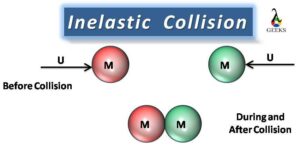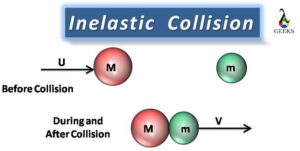In the occurrence of an inelastic collision, the kinetic energy is not conserved.
The definition of the inelastic collision itself exclaims that it is the opposite of elastic collision, and thus, kinetic energy is not conserved in this one.
In this type of collision, the objects collide with each other but do not rebound. Every so often, it also causes deformation in the object.
In this article, we shall try to answer questions like is kinetic energy conserved in an inelastic collision, why and when kinetic energy is conserved, is it conserved at all or not.
Why is kinetic energy not conserved in an inelastic collision?
Conservation of Momentum transpires in both elastic as well as inelastic collisions.
Momentum is sustained, but kinetic energy is not sustained in the occurrence of an inelastic collision. Thus, it would be converted into some other form of energy.
In an inelastic collision, the system’s momentum before the collision will equate to the system’s momentum after the collision. But, the kinetic energy is lost to the surrounding by converting into heat or sound or into some other type of energy form.
Therefore, sometimes the colliding objects stick together, though this property highly depends on the material of the body. For example, let us consider two balls made up of the same material with equal mass (M) and move towards each other with equal velocities (U).
The initial total kinetic energy for this system can be given as:
(1/2)MU2+(1/2)MU2 = MU2
Now, they stick together as soon as they collide. This conserves momentum, but the system’s kinetic energy after the collision will become zero. Such a collision is regarded as a perfectly inelastic collision, as the reduction of kinetic energy in this collision is highest than any other collision.
It is easier to answer the question ‘Is Kinetic Energy Conserved in an Inelastic Collision?’ with the help of the example of perfectly inelastic collision.

Sometimes, one object drags another object; this happens when one object has greater mass than another object or when one object is at rest.

Also, read about Is Kinetic Energy Conserved in an Elastic Collision.
How is kinetic energy conserved in an elastic collision but not in an inelastic collision?
Kinetic energy will fabricate into other forms of energy when an inelastic collision transpires.
When the objects collide, more often than not, there might be a rearrangement of atoms or molecules inside the body, due to which the kinetic energy is converted into another form. Hence, it is not conserved.
As mentioned earlier, the material of the object plays a significant role in deciding if the collision will be elastic or inelastic. If a rubber ball is thrown towards a wall, it will rebound when collided. As a result, we can say that it is an elastic collision.
But if a glass ball is thrown towards a wall, it will immediately break into pieces when collided. Thus, as a result, we say that it is an inelastic collision.
In the case of a rubber ball, the ball was deformed, but for a very brief moment, and all the energy worked to reform the ball to its original shape and size. Therefore, it is an elastic collision.
In the case of a glass ball, all the energy worked in breaking the ball. Consequently, the bonds between the molecules were broken, and a sound was produced. Therefore, it is an inelastic collision.
In both cases, work was done, but the energy was transferred into different forms, which caused the collision to be either elastic or inelastic.
Thus, with the help of this example, we can answer the question ‘Is kinetic energy conserved in an inelastic collision?’
Also, read about 15 List of Potential Energy to Kinetic Energy Example.
FAQs
With the help of a few examples, let us try to answer the question ‘Is kinetic energy conserved in an elastic collision’?
- The formula for collision in one- dimension is given as:

| Where, | V1 and V2 = final velocities of object 1 and object 2, respectively. |
| U1 and U2 = initial velocities of object 1 and object 2, respectively. | |
| M1 and M2 = mass of object 1 and object 2, respectively. | |
| CR = Coefficient of restitution |
Coefficient of Restitution – it is the ratio of final to initial velocities of objects after the collision. If the value of the coefficient of restitution is 0, then it would be a perfectly inelastic collision. If the value of the coefficient of restitution is between 0 and 1, then it would be real- world inelastic collision. And if the numerical value of the coefficient of restitution is 1, then it ought to be a perfectly elastic collision.
- The formula for perfectly inelastic collision.
When a perfectly inelastic collision occurs, the objects stick together and move in one direction. The formula for this scenario is given as:

| Where, | V= final velocity of the system. |
| U1 and U2 = initial velocities of object 1 and object 2, respectively. | |
| M1 and M2 = mass of object 1 and object 2, respectively. |
Hence, with the help of all these examples and questions, we were able to answer the question ‘Is kinetic energy conserved in an inelastic collision?’
Two balls have the same mass (1 Kg). Find the momentum and kinetic energy of the system of two balls before and after the collision if ball 1 is moving with a velocity of 2 m/s, and ball 2 is at rest.
Given that:
ball 1 is moving with a velocity of 2 m/s towards ball 2. Ball 2 is at rest.
The kinetic energy for this system before the collision is given as:

The momentum for this system before the collision is given as:
mv + mv = (1)(2) + (1)(0) = 2 + 0 = 2 kg m/s
As the balls collide, the velocity of ball 1 decreases, and the velocity of ball 2 increases. If the new velocities are:
Ball 1 = 1 m/s and ball 2 = 1 m/s.
Then the kinetic energy for this system after the collision is given as:

And the momentum for this system after the collision is given as:
mv + mv = (1)(1) + (1)(1) = 1 + 1 = 2 kg m/s
Thus, if asked ‘Is kinetic energy conserved in an inelastic collision?’ then the answer to this question can be given as:
The phenomenon if inelastic collision is such that the momentum is maintained, but the kinetic energy is never maintained in an inelastic collision.
Hence, with the help of all these examples and questions, we were able to answer the question ‘Is kinetic energy conserved in an inelastic collision?’
Two kids are playing on a long slide. Kid A of mass 30 Kg is sliding at the speed of 4 m/s. Kid B of mass 25 Kg is sliding on the same slide, but before kid A, at the speed of 3 m/s. Kid A collides with kid B and keeps sliding down as one unit. Calculate the resulting velocity of kid A after the collision.
| Given that: | MA = mass of kid A = 30 Kg |
| MB = mass of kid B = 25 Kg | |
| UA = initial velocity of kid A = 4 m/s | |
| UB = initial velocity of kid B = 3 m/s | |
| To find: | VA = final velocity of Kid A = ? |
For finding the final velocity of kid A after the collision, we have the formula:

VA = 3.54 m/s
Therefore, the final velocity of kid A after the collision is 3.54 m/s.
Hence, with the help of all these examples and questions, we were able to answer the question ‘Is kinetic energy conserved in an inelastic collision?’
Also Read:
- Is kinetic energy conserved in an elastic collision
- Chemical energy to sound energy
- Mechanical energy examples
- Example of electrical energy to chemical energy
- Light energy examples
- Example of electrical energy to radiant energy
- Example of electrical energy to kinetic energy
- Example of kinetic to thermal energy
- Radiant energy to chemical energy
- Example of radiant energy
I am Durva Dave, completed my post-graduation in Physics. Physics fascinates me a lot and I like in knowing the ‘Why’ and ‘How’ of everything that unfolds in our universe. I try to write my blogs in simple yet effective language so that it is easier for the reader to understand as well remember. I hope with my curiosity I am able to provide the readers for what their looking for through my blogs. Let’s connect through LinkedIn.